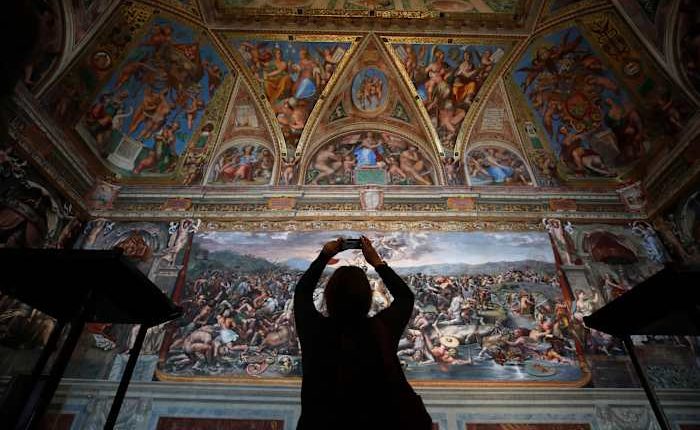Share this @internewscast.com

VATICAN CITY – The Vatican Museums revealed the final and most significant of the freshly restored Raphael Rooms on Thursday. These breathtakingly frescoed reception rooms within the Apostolic Palace stand as a stunning testament to high Renaissance artistry, comparable to the renowned Sistine Chapel.
The decade-spanning effort to clean and restore the largest of the four distinct Raphael Rooms has surfaced a remarkable painting technique initiated but never finished by the legendary Renaissance artist and architect. Raphael experimented with applying oil paint directly onto the wall and utilized a grid of nails embedded in the walls to support the resin surface for his painting.
During the inauguration of the Room of Constantine on Thursday, Vatican Museums officials shared the fascinating findings as the final scaffolding was removed. This reception room, started by Raphael and his students in the early 1500s, pays homage to the fourth-century Roman emperor Constantine, who was instrumental in spreading Christianity across the Roman Empire.
“With this restoration, we rewrite a part of the history of art,” Vatican Museums director Barbara Jatta said.
Pope Julius II summoned the young Raphael Sanzio from Florence to Rome in 1508 to decorate a new private apartment for himself in the Apostolic Palace, giving the then 25-year-old painter and architect a major commission at the height of his artistic output.
Even at the time, there were reports that Raphael had wanted to decorate the rooms not with frescoes but with oil paint directly on the wall, to give the images greater brilliance. The 10-year restoration of the Rome of Constantine proved those reports correct, said Fabio Piacentini, one of the chief restorers.
Vatican technicians discovered that two female figures, Justice and Courtesy and located on opposite corners of the hall, were actually oil-on-wall paintings, not frescoes in which paint is applied to wet plaster. They were therefore clearly the work of Raphael himself, he said.
But Raphael died on April 6, 1520, at the age of 37, and before the hall could be completed. The rest of the paintings in the room were frescoes completed by his students who couldn’t master the oil technique Raphael had used, Jatta said.
During the cleaning, restorers discovered that Raphael had clearly intended to do more with oil paints: Under the plaster frescoes, they found a series of metal nails which they believed had been drilled into the wall to hold in place the natural resin surface that Raphael had intended to paint onto, Piacentini said.
“From a historical and critical point of view, and also technical, it was truly a discovery,” he said. “The technique used and planned by Raphael was truly experimental for the time, and has never been found in any other mural made with oil paint.”
The final part of the restoration of the room was the ceiling, painted by Tommaso Laureti and featuring a remarkable example of Renaissance perspective with his fresco of a fake tapestry “Triumph of Christianity over Paganism.”
The Raphael Rooms were never fully closed off to the public during their long restoration, but they are now free of scaffolding for the many visitors flocking to the Vatican Museums for the 2025 Jubilee.
___
Associated Press religion coverage receives support through the AP’s collaboration with The Conversation US, with funding from Lilly Endowment Inc. The AP is solely responsible for this content.
Copyright 2025 The Associated Press. All rights reserved. This material may not be published, broadcast, rewritten or redistributed without permission.











